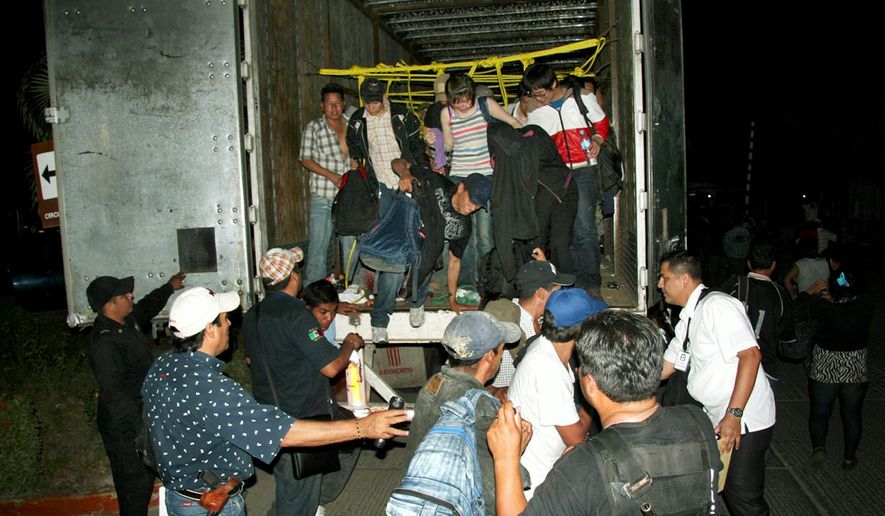MEXICO CITY — X-ray machines at checkpoints in southern Mexico are capturing the ghostly outlines of a clandestine business worth billions a year, people packed tighter than cattle and transported like consumer goods in tractor trailers to the United States.
The machines in place for less than two years at two state police checkpoints have led to the two largest hauls of migrants, who pay anywhere from $7,000 to $30,000 for passage, depending upon where they start.
The United Nations estimates that smuggling migrants across Mexico’s border with the U.S. alone is a $6.6 billion business annually, compared to an estimated the $10 billion to $29 billion in illegal drug running.
The migrant smuggling estimate doesn’t include another $1 billion paid by thousands of non-Mexicans to cross from Guatemala and travel north, according to a 2010 U.N. report on transnational crime.
The 513 people apprehended last week in two trailers in the state of Chiapas, bordering Guatemala, represented at least $3.5 million in cargo. Another trailer filled with 219 people was discovered in January.
“As far as I know, this is the first time we’ve seen such big numbers, but it does confirm what we already knew,” said Antonio Mazzitelli of the regional U.N. Office on Drugs and Crime. “There are more and more people coming from all other regions of the world using the Central American and Mexican corridor to reach the North American market.”
While the majority of migrants found were Guatemalan, there were also Indians, Nepalese and Chinese.
Smuggling in decades past was the business of small independent operators who helped migrants cross once they reached the U.S. border. But evading U.S. authorities has become much more difficult with increased border enforcement in recent years.
At the same time, Mexico’s migrant routes have become much more dangerous, controlled by drug gangs that see new moneymaking opportunities in kidnapping and extorting those who cross their territory.
The harder the trip, the higher the price. Guatemalan officials, who estimate 300 to 500 undocumented nationals cross the border each day into Mexico, say those migrants are paying double what they did two years ago, as much as $10,000 for the hope of gaining work in the United States.
“According to the testimony given our staff, the cost of migration rises every day,” Fernando Batista Jimenez, an investigator for Mexico’s National Commission on Human Rights, said in an email.
“Not only because of the walls, policies and legislation against migrants, but because of the ever-expanding presence of organized crime, given the lack of coordination among three levels of government to fight it.”
Unlike those running drugs, guns or other contraband, people smugglers lose virtually no upfront costs when migrants are intercepted by authorities or escape.
By 2006, 95 percent of Mexicans crossing illegally into the U.S. were paying smugglers, according the U.N. report, which says that most migrants are now transported in trucks.
They also are found in the U.S., where in the most deadly case, 19 Central Americans suffocated inside a sweltering tractor-trailer near Houston in 2003.
In the case of Mexico’s southern border, no one can say exactly who the organized smuggling groups are. Some say that large transport rings operate separately from Mexico’s brutal drug gangs, such as the Zetas or the Gulf Cartel, who stick to kidnapping and extortion.
Some say they are all in collusion, including authorities. Both local police and federal immigration agents have been arrested in recent raids on kidnapping operations in Reynosa, across the border from McAllen, Texas.
“It’s clear that they’re immigration agents, federal police, Zetas, maras, the whole gamut, along with local crime groups,” said the Rev. Alejandro Solalinde, a Catholic priest who runs a migrant shelter in Oaxaca. “Those who make money off migrants are all part of the same mafia.”
Immigration authorities in Chiapas said the migrants couldn’t say where they crossed from Guatemala and wouldn’t say how they contacted their smugglers, much less whether the smugglers were part of a larger organized group.
Some suffered from dehydration after traveling for hours clinging to cargo ropes strung inside the containers to keep them upright, allowing more migrants to be crammed in.
Air holes had been punched in the tops of the containers, but migrants interviewed at the state prosecutors’ office said they lacked air and water. The trucks were bound for the central city of Puebla, where the migrants said they had been told they would be loaded aboard a second set of vehicles for the trip to the U.S. border.
Loads of this size may have been crossing for some time. The difference now is that the blank white trucks passed through an X-ray machine and then took off, refusing to stop once authorities saw what was inside. They were chased about 10 miles until police cut them off.
Police arrested four people in the case.
“We don’t know how many immigration checkpoints there were before that,” said Hector Sipac, the Guatemalan consul in Mexico City, noting that any number of similar loads could have been waved through.
State authorities say they have had two checkpoints in Tuxtla Gutierrez with permanent X-ray machines for just under two years. A year ago, the federal government provided two more that are mobile and can be used around the state by the army, navy and immigration officers.
While the permanent stations have netted the largest groups of migrants, the mobile machines have caught loads of drugs and other contraband, plus smaller groups of migrants, said state government spokesman Jose Luis Coutino.
Still, nothing seems to stop people from seeking the American dream.
“We’re seeing a rise in recent months. The apprehensions are happening almost daily, though this is the second large one,” said Juan Jose Gonzalez, the head of the nonprofit group Southern Border Movement. “And each time the smugglers charge more to move people north.”




Please read our comment policy before commenting.